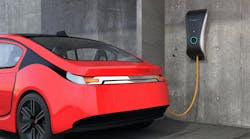Here are EW's picks for the trends that changed the electrical wholesaling industry most over the past decade. Part 1 of two parts.
Ten years ago, Electrical Wholesaling published in article called "Future Gazing," in which electrical distributors, reps and manufacturers offered their opinions on the trends that would have the most impact on the electrical wholesaling industry in the 1990s. In many cases, their prognostications were dead-on.
Many of the respondents said the wave of M&As that was sweeping over this industry back then would continue. Others foresaw the rapid growth of alternate channels to market, such as Home Depot and Grainger. Back then these companies were on the industry's radar screen but had not yet grown to their present-day prominence.
But the respondents were off the mark in some other areas. For instance, many of them saw a decade where global sales would become a much bigger market for more companies. The global market has had a dramatic impact on the industry over the past 10 years, but not in the ways that some of the article's respondents expected.
The biggest surprise in the past decade has got to be the evolution of the Internet. In 1990, outside of a few research scientists in universities, the military and government, few people knew that the Internet existed, or saw its potential in the business world.
Here are EW's picks for the 10 trends that had the most impact on the electrical wholesaling industry during the past decade-and what influence each of these trends may continue to have in the future.
1. Mergers and acquisitions change the face of the electrical business, but family-owned companies are still surviving and thriving.
Because of all of the M&A activity since the beginning of this decade, the electrical wholesaling industry has a different look to it today. Dozens of family-owned electrical distributors were acquired over the past 10 years. In this year alone, several of the most respected family-owned businesses in the industry were sold to larger companies. The Coghlins of Coghlin Electric/Electronics, Kinneys of All-Phase Electric Supply and Waltersdorfs of Tristate Electrical Supply were just a few well-known families in this business that decided that the time was right to sell their companies; many other families sold their companies since 1990 (See sidebar, "The Biggest Acquirers in the 1990s," on page 41.)
Yet compared to wholesale-distribution industries such as the electronics and pharmaceutical markets, which are in more advanced stages of consolidation, the electrical business is still quite fragmented. Indeed, in a market with over 4,000 distributors of electrical supplies, the 250 largest electrical distributors in the U.S. still account for less than half the market.
The future. Don't expect M&As to stop any time soon. As long as commercial credit is still available to fuel purchases, the economy remains healthy and there's a ready supply of attractive acquisition candidates, all indicators point to even more acquisitions down the road.
Several key reasons exist for this. Demographically speaking, the "graying" of the industry is still in full swing. Many owners who started electrical supply houses or took them over from other family members are near or at retirement age, and if they don't have any family in the business willing or capable of taking it over, a sale is often in the cards. For many distributors who realize that they have to get bigger to survive, the cost of growing the business is formidable. One of the biggest costs is information technology, where investments in business system upgrades, portable computing equipment, Web site development, bar coding, and the personnel to manage it all will only increase in the future. It's an investment that many companies don't want to make.
New acquirers in the acquisition game are another major factor that will boost the number of acquisitions in the coming years. For much of the decade, CED, Rexel, GE Supply, Crescent Electric Supply, Graybar and more recently WESCO were the companies making acquisitions on a national scale. But in the past two or three years, other acquirers from outside the U.S. have established or built up footholds in the U.S. market: France's Sonepar, Canada's Westburne, and most recently, Hagemeyer NV of the Netherlands.
Yet the acquisitions that will occur in the next few years will not drive family businesses out of the market. With all of the advantage of critical mass that larger companies have, it won't get any easier for smaller companies in the 21st century. But as long as a family-owned business can build and maintain the strongest customer relationships and outhustle and outserve larger competitors, they will get their fair share of the business.
2. The Internet sweeps EDI and bar coding off center stage in the electronic commerce arena.
Think back 10 years to 1990. The term "e-commerce" wasn't yet coined, so when we discussed things like bar coding, and electronic data interchange (EDI) (which the electrical industry then called EDX), they some usually got lumped under "computerization." In the early 1990s, a forward-thinking distributor like W.W. Grainger was already receiving electronic transactional information from its branches to its headquarters via satellite dishes, but many electrical distributors, manufacturers and reps were still arguing over whether EDI was a good idea or not.
It's hard to believe it, but during the early 1990s, CD-ROMs were just starting to edge into the business world, and when we talked about their then mind-numbing information capacity, we talked in terms of how many floppy disks of stuff they could hold. Online services like American Online and CompuServe were not yet in full stride at the dawn of this decade, and were only popular with the more computer-literate among us.
What a difference a few years make. Somehow between then and now, the electrical industry has vaulted from a mostly unconnected world to a distribution business that in some ways is leading the charge, compared to other wholesale-distribution businesses. The electrical industry has matured from squabbling over the development of EDI standards into a universal electronic language that's the foundation for the Industry Data Warehouse (IDW). The IDW uses these EDI standards in an industry extranet that gives users 24-by-7 access to a centralized electronic repository of consistently updated product and transactional information. It's positioned to allow manufacturers, distributors and reps to send, receive and track orders in real-time, and will have additional electronic-communication capabilities in the future.
The IDW is still in its early implementation phase, and some critics say that new e-commerce languages like XML specifically designed for Web-based commerce will spark the development of alternate on-line business options for the electrical industry. However, the IDW stands as the electrical wholesaling industry's best example of how distributors, manufacturers, reps and industry trade groups can put aside their own turf battles and work toward a common goal that can benefit the entire industry.
Not all of the initiatives developed in the1990s in the electronic commerce arena had as much success. After intriguing potential users in the mid-1990s with the benefits of a centralized product database on CD-ROMs, the AnswerPro CD-ROM catalog developed by Sterling Commerce and marketed by the National Association of Electrical Distributors (NAED), St, Louis, Mo., never generated enough support to make it a viable option. Debates over its field formats and a lack of input from potential users within the electrical industry during its development phase left snuffed out enthusiasm for AnswerPro. A contributing factor was that by the time the first AnswerPro CD-ROMs hit the market, online product databases were already being loaded onto the Internet, with their inherent cost savings in updates and timeliness.
Electrical manufacturers also spent a ton of time and resources over the past few years on another tool of electronic commerce that has yet to achieve widespread usage: vendor-managed inventory (VMI). With VMI, distributors and manufacturers work together to slash operating costs by eliminating many of the expenses associated with the traditional purchasing process. VMI helps redeploy a distributor's inventory investment from dead stock to faster-moving items. While relatively few distributors utilize VMI, those that do have had very good experiences with it. One factor that seems to have stunted VMI's popularity is a reluctance on the part of distributors to part with so much order-history data to a manufacturer, because of a fear that a manufacturer will know too much about their businesses.
The future. As the next decade approaches, the electrical wholesaling industry seems to be at a crossroads with e-commerce. The IDW, online electrical auction sites and alternative online purchasing options have the power and potential to totally transform how business is done in this industry. The billion-dollar question is just how much purchasing in the electrical business will go electronic. Web heads sometimes forget that just because something is technologically doable doesn't mean the customers want it. Online purchasing must life easier for customers to explode the way its proponents expect. The most likely scenario is that there will always be customers-particularly smaller companies-who prefer existing traditional shopping methods, and that online purchasing will be an option that all distributors will have to offer.
Yet, even if online purchasing grows incrementally, that translates into big money. For instance, for a huge distributor with $100 million in sales, every percentage point is worth $1 million. If over the next five years, 10% of that company's business (a conservative estimate, according to some futurist's forecasts) goes electronic, that's $10 million. If that distributor takes a "wait-and-see" strategy and does not have the technological capabilities to capture those order electronically, that's $10 million in business that could be gone forever to other competitors.
3. The electrical industry embarks on the search for the perfect process.
The commitment of many companies to the Quality Process and ISO certification can be summed up in some ways as the anti-thesis to Nike's slogan "Just Do It." The battle cry for a Quality or ISO crusade might very well be, "Don't ju"1/25/00 12:23:43 PM","Inbound","[email protected]","[email protected]","2806","Fwd: (no subject)" st do it. Figure out a way to do it better, and then measure what you have done." Indeed, with gross margins averaging about 20% and net margins hovering in the low single digits, companies were looking for new ways to squeeze out every possible extraneous transaction cost. The Quality Process, first popularized in the electrical industry by Dr. Donald Rice and the folks at Texas A&M University, focuses on perfecting a company's operating procedures process-by-process. On the other hand, ISO certification forces companies to measure all their processes and to then document that they fact that they are measuring these processes. ISO first came to this industry through the end-user community, where industrials demanded that their supplier become ISO-certified.
Converts to these philosophies embarked on these quests for Quality and ISO certification to locate unnecessary costs, eliminate errors and reinvent and reinvigorate their transaction processes. But as anyone who has been through the experience will tell you, committing to a Quality or ISO regime is not a quick fix, it's an excruciating workout. These strategies are not cosmetic surgery that can get rid of a flabby process in a business. And if anyone is looking for reasons why more companies don't get involved with Quality or ISO, it's probably because they were not willing to make them a way of their daily business lives. Electrical companies also began using other strategies to perfect their business processes during the 1990s. On such process, activity-based costing (ABC), involves attaching a cost to each and every process in a business. It's an excruciating workout not unlike that required by Quality or ISO, because it forces distributors and other companies to analyze costs more closely than ever. Believers in ABC say it uncovers nuggets of cost savings and information that they had never otherwise been able to find.
Another movement that took root in the 1990s was electrical distributors' search for new ideas in other distribution industries. It was spurred on in part by the "Facing the Force of Change" series of studies published by the National Association of Wholesale-Distributors (NAW), Washington, D.C., and the Arthur Andersen consulting firm. The concept basically is that electrical distributors can learn from distributors in other industries, because many of the core business procedures driving any wholesale-distributor are the same, whether that company is moving boxes of lamps and locknuts or sparkplugs, shingles or propane.
The future. The Quality Process and ISO will remain very viable business philosophies, but the concept of learning from distributors in other industries is a very sound concept that hasn't yet got a lot of traction. More electrical distributors should get to know distributors from outside the electrical industry, too. And if you aren't a member of NAW check out this organization.
4. Global commerce evolves differently than anticipated.
While there were some notable acquisitions of U.S. electrical manufacturers by foreign players during the past decade, there really hasn't been a deluge of new manufacturers from offshore flooding the mainstream U.S. electrical business. And most people don't even think of foreign-owned companies with established U.S. operations like Siemens, Philips Lighting, Groupe Schneider as "foreign" because they have been around for so long, Two of the biggest acquisitions from offshore during the 1990s included Groupe Schneider's acquisition of Square D and Siemens AG's purchase of Sylvania through its Osram operating company.
The one aspect of the global market that probably had the most impact on the U.S. electrical wholesaling industry in the past 10 years was the trend toward offshore manufacturing and assembly. Years ago, when a company announced it was setting up operations offshore, the decision was met with a storm of protest. Nowadays, these announcements usually pass without much public comment, as it's become an economic fact of life in many industries that the actual manufacturing will be done where total costs are the least, and in many cases, that has been offshore.
The future. Prepare for more manufacturing to shift to countries that can do it most cost competitively. Your industrial customers will always be looking for ways to cut production costs, and if they can do so without sacrificing quality in a maquiladora plant on the Texas/Mexico border or in a factory in Asia, that may be a option they will consider. You can also expect the Internet to have global ramifications in the electrical industry, too, because the Web gives potential customers in remote areas the same access to information as a customer down the block.
4. Customers embrace other buying options, but the full-line electrical distributor still rules the electrical channel.
Industry analysts looking back at the 1990s may peg this decade as the time when the flow of electrical products began to dramatically split off into different channels away from the mainstream route through electrical supply houses. Electrical distributors are still selling close to 80% of all electrical products, but sales of electrical products through alternate channels like Grainger and Home Depot had easily topped a billion dollars and show no sign of slowing down.
The future. Like any business, the electrical manufacturer must constantly reevaluate his or her business strategies, and in this business the one strategy that seems to always be up for review is the use of the electrical distributor as the primary path to market. EW's editors know this from personal experience. One of the most popular articles published in the magazine over the past 10 years was a series of articles analyzing various channels to market. The "Electrical Pyramid" chart in those articles showing the various channel options was reproduced as an overhead and used in many a executive-level meeting to help company managers analyze their own distribution methods. Distributors should expect this type of analysis to continue in the future.
5. Membership ranks explode in the electrical industry's buying/marketing groups.
The past 10 years were a time of phenomenal growth for the electrical industry's buying/marketing groups, as all of the major groups added members and suppliers to their membership roles. They also added many different value-added services for their members in addition to their core role in helping distributors pool their purchasing power for volume discounts or rebates based on annual purchases from participating manufacturers. These services included analyses of new business opportunities, and, in some cases, avenues to integrated-supply and national-account contracts.
About half of the 250 largest electrical distributors are members of one of the industry's buying/marketing groups. With this type of popularity amongst the largest distributors, it's easy to see how buying/marketing groups have changed the way the electrical industry does business.
Over the past decade, membership in buying/marketing groups has exploded. EW estimates that about 600 electrical distributors with a combined total sales volume of $17 billion are now members of one of the five buying/marketing groups:
Affiliated Distributors has over 180 electrical distributors operating 1,500-plus branches in U.S., Canada and Mexico. The $8 billion in combined sales volume of its U.S. and Canadian affiliates is an estimated 15% of the total sales of electrical products in the U.S. and Canada. Founded in 1981, A-D is the largest and oldest of the buying/marketing groups. A-D strives for paperless communication between all members, and in 1997 issued a no-nonsense edict to all members demanding communications with A-D headquarters via e-mail. A-D is moving fast the industrial supply and PVF industries, and has a major focus on integrated supply.
IMARK, Upper Marlboro, Md. IMARK, with 185 electrical distributors, 950 locations and about $6 billion in combined member sales volume, is the second-largest buying/marketing group. The group is the result of the 1995 merger between the TIED and WIED buying groups.
Equity Electrical Associates, East Walpole, Mass. Formed in 1989, Equity has over 185 members with 288 branches members and a members' sales volume of over $3 billion. The group has many smaller electrical distributors, as well as few large companies ranked on Electrical Wholesaling magazine's 250 Biggest listing. United Purchasing Association (UPA), Sanford, Fla. and Electrical Distributors Network (EDN), Beachwood, Ohio, are also recruiting electrical distributors as members. UPA is also active in the plumbing field.
The future. Buying/marketing groups will command ever-greater mind share of their distributor and manufacturer members in the future. The rebate dollars that distributors get from these groups have a lot to do with their popularity, but the organizations' executives are constantly striving to give their members more reasons to participate other than the rebates.
Anicom, Inc., Rosemont, Ill.: Carolina Cable & Connector, Ibc, Raleigh, N.C. Energy Electric Cable, Inc., Auburn Hills, Mich. Medisco, Inc., Indianapolis, Ind. Morgan Hill Supply Co., Kingston, N.Y. Northern Wire & Cable Co., Troy, Mich. Norfolk Wire & Electronics, Virginia Beach, Va. Pinnacle Wire and Cable, Columbus, Ohio Security Supply, Inc., New Orleans, La. Superior Wire and Cable, Inc., Tulsa, Okla. Texcan Cables, Vancouver, British Columbia Western Wire & Alarm, Denver, Colo. Yankee Electronics, Inc., Manchester, N.H.
Branch Group, Inc., Upper Marlboro, Md.: Interstate Electric Supply Co., Chantilly, Va. Electric Specialty and Supply Corp., Boston, Mass. Massachusetts Gas & Electric Co., Boston, Mass. Penn State Electric Supply Co., Lancaster, Pa.
Communications Supply Corp., Downers Grove, Ill.: Computel, Inc., Springfield, N.J. Diversified Wire & Cable Technologies, Inc., Troy, Mich. Fibertron Corp., Buena Park, Calif. GNWC, Wire, Cable and Network Products, Downers Grove, Ill. Southwest Wire & Cable, Inc.
Consolidated Electrical Distributors, Inc., Westlake Village, Calif.: All-Phase Electric Supply Co., Benton Harbor, Mich. American Electric Co., St. Joseph, Mo. (from Sun Distributors, Inc.) Best Electric Supply Co., Inc., Beaumont, Texas Capital Electric Group, Phoenix, Ariz. Chappell's Electric & Solar, Inc., London, Ky. City Electrical Supply of California, Novato, Calif. County Wholesale Electric Co., Orange, Calif. Electrical Distributors, Inc., Anchorage, Alaska Guillevin International, Inc., Montreal, Quebec Hansen Wholesale Electric, Orem, Utah Hussar Electric Supply Co., Inc., Tuscon, Ariz. Keathley-Patterson Electric Co., Little Rock, Ark. (from Sun Distributors, Inc.) Lappin Electric Co., Milwaukee, Wis. Magic Valley Electrical Supply, Inc., Twin Falls, Idaho Mosebach Electric & Supply Co., Inc., Pittsburgh, Pa. The electrical business of Mill Power Supply Co., Charlotte, N.C. Counter operation of North Supply Co., North Kansas City, Mo. Philips and Co., Columbia, Mo. (from Sun Distributors, Inc.) Raybro Electric Supplies, Inc., Tampa, Fla. Saddleback Wholesale Electric, Inc., Laguna Niguel, Calif. Stusser Electric Co., Seattle, Wash. Triangle Electric Supply Co., El Paso, Texas United Electric Supply Co., New London, Conn. Valmac Electric Supply, Inc., McAllen, Texas
Note: With the exception of its acquisition of All-Phase Electric Supply this year, CED's acquisition hunt has slowed down recently. But counting the All-Phase acquisition the company has added close to 500 locations since 1970-mostly through acquisition.
Crescent Electric Supply Co., East Dubuque, Ill.: DESCO, Inc., Nashville, Tenn. Debenham Electric Supply Co., Inc., Anchorage, Alaska Electric Supply, Inc., High Point, N.C. Iowa Electric Supply Co., Fort Dodge, Iowa Loos Electric Supply Co., Scotts Bluff, Neb. Tri Electric Supply, San Marcos, Calif. Westar Electric Supply Co., Portland, Ore.
GE Supply, Inc., Shelton, Conn.: Cal Tech Controls, Livermore, Calif. Cashway Electric Supply, Denver, Colo. M. Keilliher and Sons Ltd., Tralee, Ireland Uhr Electric Supply Co., Inc., Cherry Hill, N.J. Unilec Corp., Scottsdale, Ariz.
Graybar Electric Co., St. Louis, Mo.: Besco Electric Supply Co.'s Ocala branch Ellis & Howard Ltd., Kitchener, Ontario H&C Electric Supply, Inc., Mankato, Minn. Monroe Contractors Electrical Supply, Monroe, LA. Square Electric Supply Co., Parsippany, N.J. Frank A. Blesso, Inc., Hartford, Conn.
Hughes Supply, Inc., Orlando, Fla.: Causey Electrical Supply Co., Macon, Ga, Elec-Tel Supply Co., Marietta, Ga. Electrical Distributors, Inc., Chamblee, Ga. Electric Laboratories and Sales Corp., Mattoon, Ill. Fife/Florida Electric Supply, Tampa, Fla. Moore Electric Supply, Inc., Charlotte, N.C. Port City Electrical Supply, Savannah, Ga. Wholesale Electric Supply Corp., Vestal, N.Y. Winn-Lange Electric, Inc., Houston, Texas
Rexel, Inc., Coral Gables, Fla. (Owned by Rexel SA of Paris, France): Cable & Connector Warehouse, Inc., Dallas, Texas Consolidated Electric Supply Co., Miami, Fla. Chemco Electric Supply, Tampa, Fla. Norcal Electric Supply, Inc., Redding, Calif. Pacific Electrical Supply, Inc., San Leandro, Calif. The Sacks Group, Akron, Ohio Southern Electric Supply Co., Inc., Meridian, Miss. (1987) Summers Group, Dallas, Texas Taylor Electric, Inc., Portland, Ore.
Note: CES were very active acquirers before being purchased by Rexel. The companies that they acquired include Cummins Supply Co., Fort Worth, Texas; Danels & Ellis Supply, Pensacola, Fla.; Delta Electric Supply, Ocala, Fla.; Glasco Electric Co., St. Louis, Mo.; Jones Electric Supply Co., Inc., Sanford, Fla.; Sharonville Electric Supply Co., Cincinnati, Ohio; and Seaco Electrical Supplies, Panama City, Fla. Valley Electric Co., Manteca, Calif.
Sonepar USA, Berwyn, Pa. (Owned by Sonepar of France): Cooper Electric Supply Co., Tinton Falls, N.J. Eagle Electric Supply Co., Norwood, Mass. Lee Electric Co., Baltimore, Md. Marle Co., Stamford, Conn. Seven locations of Branch Group's New England division Several of All-Phase Electric Supply's New England branches World Electric Supply, Miami, Fla.
WESCO Distribution, Inc., Pittsburgh, Pa.: Several branches of Ace Electric Supply, Jacksonville, Fla. Avon Electrical Supplies, Inc., Hauppage, N.J. Brown Wholesale Electric, Inc., Sun Valley, Calif. Bruckner Supply Co., Port Washington, N.Y. Coghlin Electric & Electronics, Westborough, Mass. Diversified Electric Supply Co., Inc., North Little Rock, Ark. Fife Electric, Detroit, Mich. Hamby-Young Power Products, Aurora, Ohio Industrial Electric Supply Co., Birmingham, Ala. Liberty Electrical Supply Co., Inc, Brooklyn, N.Y. Maydwell and Hartzell, Inc., Brisbane, Calif. Murco, Inc., Monroe, La. Power Supply, Inc., Houston, Texas Reily Electrical Supply, Inc., Metarie, La. Standard Electric Supply, Bangor, Me. Statewide Electrical, Inc. Whitehill Lighting and Supplies, Inc., State College, Pa.
United Westburne, Inc., Montreal, Que.: Auburn Armature, Inc., Auburn, N.Y. Fluorescent Light & Fixture Co., Syracuse, N.Y. Heles Supply Co., Inc., Plymouth, Minn. Kingston Lee Watson, Co., Ontario Loyal Electric Supply Corp., Albany, N.Y. M&L Electric Co., Utica, N.Y. Richard & Cie Ltee, Ste. Foy, Quebec Wehle Electric Co., Buffalo, N.Y. Blazer Electric Supply, Colorado Springs, Colo. Colotex Electric Supply, Loveland, Colo. Electrical Supplier, Inc., Norfolk, Va.








